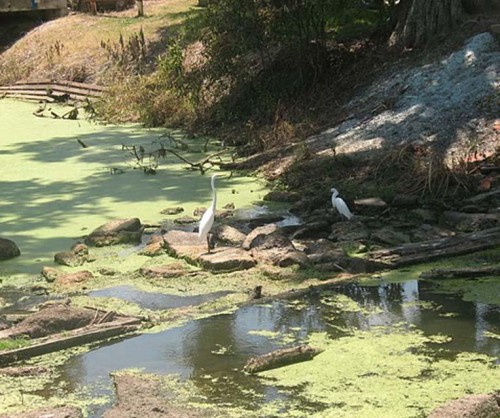Stocks of Local Interest
September 21, 2011Friday, Sept. 23
September 23, 2011Stagnant for years since being cut off from Bayou Lafourche, the waterway serves as a stormwater reservoir, with pipes and culverts directing the water to the bayou.
But Bayou Terrebonne is also the landing point for sewage systems that have largely not been in compliance with regulation for years, which contributed to the bayou landing on the state’s impaired waterways list and prompted the ongoing purification response aimed at making the watershed suitable for humans and marine wildlife.
“Bayou Terrebonne is on that list for numerous things, with nutrients and pathogens being the main two,” said Jennifer Roberts, program director with Bayou Land Resource Conservation and Development. “If we can see to it that the bayou is cleaned up, then basically, what that says is it becomes a fishable, more recreational bayou. Otherwise, right now, it is sort of a festering ditch, and that’s part of the problem: People see it as a ditch and not a water body.”
Bayou Land tested 16 water samples late last year from the segment of Bayou Terrebonne that stretches from Thibodaux to the Gulf Intracoastal Waterway.
Through the testing, Roberts said, seven locations have been deemed fecal-bacteria hotspots.
The task force tested at bridge locations and found that near Bayou Gardens Bridge, the fecal count was 5,800 colony-forming units per 100 milliliters, Roberts said. It is 4,600 units per 100 milliliters near the Liberty Street Bridge and 3,100 at Darlene Street, she added.
Roberts said the acceptable level is 400 colony-forming units per 100 milliliters, or 7 percent of the bacteria count found at Bayou Gardens.
The findings also revealed a 2,100 count at the Merlin Street Bridge, and results from the next test point in the bayou showed a count of 55. “There is no real movement (in the bayou), so that tells me that there could be a point source right near Merlin Bridge,” Roberts said.
Jeff Dauzat, an environmental scientist with the state Department of Environmental Quality, said DEQ would send its surveillance teams along Bayou Terrebonne within the current fiscal year to examine sewage system permit compliance.
Recently, DEQ monitored Bayou Lafourche from Donaldsonville to Fourchon and found that 40 percent of the approximately 800 facilities inspected were not in compliance, said Dauzat, who added he expects similar findings along Bayou Terrebonne.
“I’ve done maybe nine of these across the state, and we’ve seen pretty similar results, especially when you get in these rural areas, they are just straight piping it into the ditch and there really is no treatment system,” Dauzat said.
Dauzat, a member of the task force, said the permits stipulate limits on the quality and quantity of wastewater that can be discharged from a bayou facility. The permits depend on the amount of discharge and size of the business, he said.
“The permit limits are designed (to protect human health and the environment), so we’ll monitor what they’re doing and then what type of wastewater they will generate and then formulate permit limits that will ensure human health and the environment is protected,” Dauzat said.
The state Department of Health and Hospitals is responsible for regulating discharge from residential structures.
Pending EPA approval of testing procedures, Bayou Land will sample Bayou Terrebonne bi-monthly over the course of a year, Roberts said.
As far as treating what is currently known, Roberts said her staff has identified 176 open-ended pipes hanging over the bayou along the 16-mile stretch from Thibodaux to the Intracoastal. It has not yet been determined whether specific pipes are stormwater or wastewater based, but it is a combination of both and it serves as a launch point to solve the issue.
Bayou Land will now work to identify addresses for the GPS coordinates it has on file for the “potential problems.” They will then crosscheck the addresses with a DHH master file to see which pipes belong to septic systems and, of that set, which ones have lapsed on inspection.
“At this point, we go into the inspection and helping people understand that they need to update or maintain their septic systems,” said Roberts, who added that she was collaborating with the task force to write grants to help residents offset some of the inherent costs.
“There are a lot of folks along that area that just don’t have a whole lot of financial resources, so this is going to be a process,” she said. “My goal is to help look for funding to help people update and maintain their systems.”
Bayou Land, DEQ, DHH and Terrebonne Parish are part of the Public Bayou Terrebonne Task Force. The Barataria-Terrebonne National Estuary Program is also participating, said Andrew Barron, a water quality program coordinator with BTNEP.
“There is a good chance that we would be able to substantially clean up the amount of fecal coliform bacteria in Bayou Terrebonne,” Barron said.
“If we are able to improve that significantly, that’s going to bring us a long way to cleaning up the problems with fish and wildlife as well.”
Roberts said a watershed protection plan would be released at next meeting, which will be held from 10 a.m. to 11:00 on Oct. 6 at the South Central Planning and Development office, located at 5058 W. Main St., Houma.
“Right now, we know we have a problem,” Roberts said. “We don’t exactly know where it’s coming from, but we know where the hotspots are. It’s a matter taking the spreadsheet and working together to pull this information together and then working with the community to clean it up.”
Bayou Land Resource Conservation and Development tested 16 locations along Bayou Terrebonne between Thibodaux and the Gulf Intracoastal Waterway, finding seven hotbeds of fecal bacteria. COURTESY PHOTO










